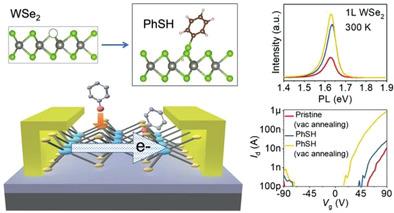当前位置:
X-MOL 学术
›
Adv. Funct. Mater.
›
论文详情
Our official English website, www.x-mol.net, welcomes your
feedback! (Note: you will need to create a separate account there.)
Molecular Functionalization of Chemically Active Defects in WSe2 for Enhanced Opto‐Electronics
Advanced Functional Materials ( IF 18.5 ) Pub Date : 2020-09-06 , DOI: 10.1002/adfm.202005045
Yuda Zhao 1 , Sai Manoj Gali 2 , Can Wang 1 , Anton Pershin 2 , Amine Slassi 2 , David Beljonne 2 , Paolo Samorì 1
Advanced Functional Materials ( IF 18.5 ) Pub Date : 2020-09-06 , DOI: 10.1002/adfm.202005045
Yuda Zhao 1 , Sai Manoj Gali 2 , Can Wang 1 , Anton Pershin 2 , Amine Slassi 2 , David Beljonne 2 , Paolo Samorì 1
Affiliation

|
Structural defects are known to worsen electrical and optical properties of 2D materials. Transition metal dichalcogenides (TMDs) are prone to chalcogen vacancies and molecular functionalization of these vacancies offers a powerful strategy to engineer the crystal structure by healing such defects. This molecular approach can effectively improve physical properties of 2D materials and optimize the performance of 2D electronic devices. While this strategy has been successfully exploited to heal vacancies in sulfides, its viability on selenides based TMDs has not yet been proven. Here, by using thiophenol molecules to functionalize monolayer WSe2 surface containing Se vacancies, it is demonstrated that the defect healing via molecular approach not only improves the performance of WSe2 transistors (> tenfold increase in the current density, the electron mobility, and the Ion/Ioff ratio), but also enhances the photoluminescence properties of monolayer WSe2 flakes (threefold increase of photoluminescence intensity at room temperature). Theoretical calculations elucidate the mechanism of molecular passivation, which originates from the strong interaction between thiol functional group at Se vacancy sites and neighboring tungsten atoms. These results demonstrate that the molecular approach represents a powerful strategy to engineer WSe2 transistors and optimize their optical properties, paving the way toward high‐performance 2D (opto)electronic devices.
中文翻译:

WSe2中化学活性缺陷的分子功能化,用于增强型光电
已知结构缺陷会恶化2D材料的电气和光学性能。过渡金属二硫化碳(TMD)容易产生硫族元素空位,这些空位的分子功能化提供了一种强大的策略,可以通过修复此类缺陷来改造晶体结构。这种分子方法可以有效地改善2D材料的物理性能,并优化2D电子设备的性能。尽管已成功开发出该策略来治愈硫化物中的空位,但尚未证明其在基于硒化物的TMD上的可行性。在这里,通过使用硫酚分子对包含Se空位的单层WSe 2表面进行功能化,证明了通过分子方法修复缺陷不仅改善了WSe 2的性能。晶体管(电流密度,电子迁移率和I on / I off比增加>十倍),但也增强了单层WSe 2薄片的光致发光特性(室温下光致发光强度增加了三倍)。理论计算阐明了分子钝化的机理,该机理源自硒空位处的巯基官能团与邻近的钨原子之间的强相互作用。这些结果表明,分子方法代表了一种工程设计WSe 2晶体管并优化其光学性能的强大策略,从而为高性能2D(光电)电子设备铺平了道路。
更新日期:2020-11-04
中文翻译:

WSe2中化学活性缺陷的分子功能化,用于增强型光电
已知结构缺陷会恶化2D材料的电气和光学性能。过渡金属二硫化碳(TMD)容易产生硫族元素空位,这些空位的分子功能化提供了一种强大的策略,可以通过修复此类缺陷来改造晶体结构。这种分子方法可以有效地改善2D材料的物理性能,并优化2D电子设备的性能。尽管已成功开发出该策略来治愈硫化物中的空位,但尚未证明其在基于硒化物的TMD上的可行性。在这里,通过使用硫酚分子对包含Se空位的单层WSe 2表面进行功能化,证明了通过分子方法修复缺陷不仅改善了WSe 2的性能。晶体管(电流密度,电子迁移率和I on / I off比增加>十倍),但也增强了单层WSe 2薄片的光致发光特性(室温下光致发光强度增加了三倍)。理论计算阐明了分子钝化的机理,该机理源自硒空位处的巯基官能团与邻近的钨原子之间的强相互作用。这些结果表明,分子方法代表了一种工程设计WSe 2晶体管并优化其光学性能的强大策略,从而为高性能2D(光电)电子设备铺平了道路。

































 京公网安备 11010802027423号
京公网安备 11010802027423号